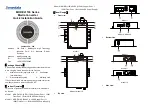
STEP #3
Reference Illustration 1, 3A, 3B, and 3C when making the following wiring connections.
> Loop the load wires the once through the ferrite core (Illustration 3A)
> Connect the Load Common lead to screw terminal TB-2 “OUT COM” (Illustration 1)
> Connect the Load Hot lead to screw terminal TB-2 “OUT HOT” (Illustration 1)
> Loop all input wires once through another Ferrite core (Illustration 3B)
> Connect the Emergency Lighting Inverter to ground using screw terminal TB-1 “FGND” (Illustration 1)
> Connect the AC Power Source Common to screw terminal TB-1 “COM” (Illustration 1)
> Loop test switch wire once through another Ferrite core. (Illustration 3C)
> Temporarily connect the test switch to X2 for installation verification purposes. The test switch will be finally installed in the
enclosure lid in step 6. (Illustration 1)
> Connect the Un-switched Hot input to screw terminal TB-1 “UWSW HOT” (Illustration 1)
> Connect the Wall switch hot wire to screw terminal TB-1 “SW HOT”. This is the means of powering the load luminaires in Normal
Mode when a wall switch is used to turn these luminaires on and off. If no wall switch is used, and the load luminaires are
controlled by the same circuit breaker that is powering the un-switched hot. In this case TB-1 “SW HOT” must be jumpered to
TB-1 “UWSW HOT”. (Illustration 1)
WIRING THE EMERGENCY LIGHTING INVERTER’S PRIMARY POWER CONNECTIONS
NOTE: Make sure all connections are in accordance with the National Electrical Code, Canadian Electrical Code and any local regulations.
• Ensure input and output primary wiring connections are made to the proper terminals. Damage to
product may occur if miswired.
• Ensure load voltage requirements match the output ratings of this product or damage to the load
devices may occur.
CAUTION
STEP #2 BATTERY INSTALLATION AND CABLE CONNECTION
This product is provided with two sealed lead-acid batteries. Only the batteries supplied by the inverter manufacturer
should be used. Install the batteries as shown, referring to Illustrations 2A and 2B.
With the unit secured to the mounting surface, begin installation by sliding the batteries into the enclosure. Connect
the battery cables using the supplied hardware. The batteries must be connected using the provided battery connection
wires. Insert the bolt into the lock-washer first, then through the retaining washer, the battery cable's ring terminal, and
finally into the threaded hole in the battery terminal (observing proper polarity by matching the cable color to the bat-
tery terminal color). Tighten to no more than 4 Ft/Lbs torque. Cover the main harness terminals with the rubber terminal
cover to protect against accidental short circuits. Open the ferrite core and pass the red and black battery connector wires
through and close (Illustration 2B). Connect the battery jumper cable last.
CAUTION:
DO NOT CONNECT the battery cables to Circuit Board connector X5 until the unit is ready for
use. The batteries WILL BE discharged after long periods of unit inactivity while connected to the circuit
board. If this occurs, the batteries will require at least 24 hours to recover before they can be used for
emergency service. If left in this discharged state for extended periods, the batteries may be damaged.
Illustration 2A
Illustration 2B
RED
BLACK
JUMPER (BLACK)
BATTERY
TERMINAL
BOLT
LOCK WASHER
RING
TERMINAL
RETAINING WASHER
RUBBER TERMINAL COVER
Illustration 3C
Test Switch Indicator
Illustration 3B
Input Wires
Illustration 3A
Output Load Wires
3
RED
BLACK
JUMPER (BLACK)
FERRITE
CORE

























